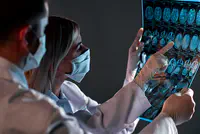One Drink Is One Drink Too Many
Though its consumption is normalized and considered acceptable in American culture, alcohol harms the mind and body, even when used “in moderation.” A recent study found that even just one drink “primes” the brain for addiction.

Most people want to protect their health as best they can, and they rely on public health guidelines, safety measures, and recommendations from physicians to do so. Unfortunately, America’s widespread acceptance of alcohol and the country’s lack of a serious critique of “moderate” alcohol consumption has made staying healthy difficult for millions. Hopefully, a recent study showing how alcohol consumption creates addiction risk will shift America’s relationship with alcohol.
What the Findings Show
A group of researchers at the University of Illinois Chicago compiled and released a study in September 2022. The key finding of the study? Even low doses of alcohol “prime the brain” for addiction. Previously, it was believed that only excessive drinking could set the stage for alcohol addiction. This study, featured in the leading science journal Nature, was the first to connect any form of alcohol consumption to addiction risk.1
The researchers found that the risk for addiction posed by alcohol consumption comes from the same areas of the brain that experience the euphoric and relaxing aspects of alcohol consumption. Critically, these brain areas can be activated after just one alcoholic beverage.
“We’re seeing that dependent behaviors may not always be from long-term, high-quantity habits but a result of rapid epigenetic changes in the brain, which we show in this study may start happening even at low doses.”
The study’s senior author, Dr. Subhash Pandey, a Joseph A. Flaherty endowed professor and director of the Center for Alcohol Research in Epigenetics at the UIC College of Medicine, pointed out how some people may be susceptible to addiction even if they limit their consumption habits to one drink. Quoting Dr. Pandey, “This suggests that when the brain experiences the anti-anxiety effects of alcohol and the mood lift – the relaxation and the buzz – it is also being primed for alcohol use disorder. We’re seeing that dependent behaviors may not always be from long-term, high-quantity habits but a result of rapid epigenetic changes in the brain, which we show in this study may start happening even at low doses.” Dr. Pandey’s findings are the first that challenge the notion that one must drink to excess to be at risk for addiction.2

The researchers found that even low-level exposures to alcohol were connected to changes in brain activity typically associated with a drop in anxiety and a sense of calm. Again quoting Pandey, “We saw that low doses, what we consider ‘social drinking,’ changes the gene expression in the amygdala, a brain region that regulates anxiety. In other words, it creates an epigenetic pathway for addiction.” Critically, it seems even low-volume consumption of alcohol (one drink) is enough to trigger the areas of the brain that become reliant on alcohol in the case of alcohol addiction.
The researchers’ conclusion? Low doses of alcohol, even just one drink or what would be considered “social drinking,” should not be considered “risk-free” consumption. Even low-volume consumption poses a risk for addiction.
Alcohol Harms the Body in Many Ways
Addiction risk is just one of the ways that alcohol harms the body. According to the National Institute on Alcohol Abuse and Alcoholism, alcohol harms critical areas of the body like:3
-
The Brain. Alcohol interferes with the brain’s communication pathways, which hampers cognitive function, memory, reaction time, reflexes, and problem-solving abilities.
-
The Heart. Drinking alcohol can harm the heart and cause health conditions like cardiomyopathy, arrhythmias, stroke, and high blood pressure.
-
The Liver. The liver is often the organ most affected by alcohol consumption, typically in the form of cirrhosis, fibrosis, steatosis, and alcoholic hepatitis.
-
The Pancreas. Alcohol consumption can cause the pancreas to produce toxic substances, which can lead to dangerous inflammation and swelling of the blood vessels in the pancreas.
-
The Immune System. Drinking alcohol harms immune function, and excessive drinking slows down the body’s ability to ward off infections – even for up to 24 hours after one consumes their last drink.
Alcohol consumption also puts people at risk for certain types of cancer. According to the National Cancer Institute, “The evidence indicates that the more alcohol a person drinks–particularly the more alcohol a person drinks regularly over time—the higher his or her risk of developing an alcohol-associated cancer. Even those who have no more than one drink per day and people who binge drink (those who consume 4 or more drinks for women and 5 or more drinks for men in one sitting) have a modestly increased risk of some cancers. Based on data from 2009, an estimated 3.5% of cancer deaths in the United States (about 19,500 deaths) were alcohol related.”4
The Safest Approach to Alcohol is to Avoid It
According to NIAAA, about 133.1 million Americans over 12 report drinking alcohol with some regularity, representing about half of the U.S. population over 12. Within that group, about 60 million Americans say they drink to excess at least once per month, suggesting about 23% of the American population drinks to excess.5
While not everyone who consumes alcohol will develop problematic drinking or alcohol addiction, most everyone who becomes addicted to alcohol started with “just one drink once in a while.” The study discussed at the beginning of this article shows that it does not take excessive drinking to push one over the edge into alcohol addiction. People are at risk for addiction just by drinking “in moderation.”
The conclusion? The safest approach to alcohol is to avoid it. If you know someone who is drinking and cannot stop on their own, even if they don’t seem to meet the traditional qualifications for alcohol addiction, they must get help at an alcohol treatment center. Please don’t wait until it is too late for them.
Sources Cited:
-
Nature. “Unraveling the epigenomic and transcriptomic interplay during alcohol-induced anxiolysis.” Nature, 2022. nature.com ↩︎
-
ScienceDaily. “How many drinks is too many?” Science Daily, 2022. sciencedaily.com ↩︎
-
NIH. “Alcohol’s Effects on the Body.” National Institute on Alcohol Abuse and Alcoholism, 2023. niaaa.nih.gov ↩︎
-
NCI. “Alcohol and Cancer Risk.” National Cancer Institute, 2023. cancer.gov ↩︎
-
NIAAA. “Alcohol Use in the United States.” National Institute on Alcohol Abuse and Alcoholism, 2023. niaaa.nih.gov ↩︎





 ®
®